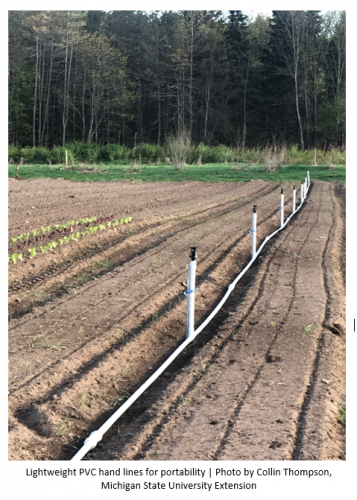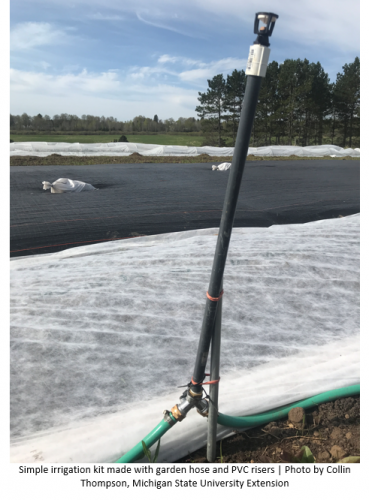Irrigation considerations for the small vegetable farm
As small-scale vegetable growers work to get crops in, it is important to have water ready in case rainfall is delayed or lacking.
Whether you are using a well or surface water to irrigate, the components of an irrigation kit are often similar, if not identical. The primary components of a system are:
- Water source – This could be a well, irrigation pond, irrigation ditch, river, etc.
- Pump – Depending on location and volume/pressure requirements, this can vary.
- Backflow Prevention – This prevents any foreign material, fertilizer or contaminants from flowing back into the water source.
- Pressure Regulator – Depending on the type of emitters, the pressure that this device regulates to can vary widely. This not only reduces the pressure, but can work to keep pressure consistent.
- Filter – There are varying types of filters, but all serve to remove particulates from the water that could plug emitters.
- Injector – These are used to apply water-soluble fertilizers through the irrigation kit.
- Adapters – These vary, but are used to connect various different types of equipment and irrigation lines.
- Distribution Lines/Main Lines – These move water from the water source to the location of application.
- Submain lines/Headers – These water lines enter the field and distribute water to the emitters.
- Emitters – Drip tape or overhead sprinklers apply the water to the crop.
Small-scale growers have many options when it comes to water application. There are two main categories of irrigation kits, as outlined below.
 Overhead Irrigation
Overhead Irrigation
This applies water using sprinklers of one form or another, offering completely coverage of larger areas. This method works well for direct seeded crops, when uniform moisture across an entire bed or field is required. It can also have a cooling effect, which can be advantageous in the heat of summer. It does typically require higher pressure and flow rates, meaning it may not be possible in all applications. Overhead irrigation is also affected more by wind and has a higher rate of loss due to evaporation and application in non-target areas. In some instances, excessive leaf wetness can lead to disease outbreaks, so drip may be favored. Examples include metal or PVC hand lines (solid set), portable sprinkler lines and water reels (traveling guns).
Drip Irrigation
Typically requiring less pressure to operate, this is a great option for transplanted crops or direct seeded crops on heavier soils. Drip irrigation applies water at the root zone on top of the soil, buried beneath the soil or under mulches. Because of direct application to target zones, wind and evaporation have less effect. On lighter soils, drip irrigation does not provide the same coverage due to increased drainage, so more lines should be used per bed. Drip irrigation requires more plastic inputs that often are discarded after a year or two of use. Depending on type of application, drip lines can also prevent or complicate mechanical cultivation systems.
 Irrigation Calculations
Irrigation Calculations
In order to know how long to run your irrigation system, you must first know the specifications of your particular irrigation system (pressure, flow rate, coverage area, etc.). You will also need to know your overall water needs. A crop’s water needs are dependent on its stage of growth, soil type and weather conditions. A good place to start is to assume a requirement of one acre-inch of water per week for vegetable crops. This is the amount of water required to cover one acre with one inch of water, or 27,154 gallons. This inch includes any precipitation or irrigation applied throughout the week. As an example, calculations for a 50 ft. x 200 ft. field are included below:
50 ft. x 200 ft. = 10,000 sq. ft.
10,000 sq. ft. / 43,560 sq. ft. (one acre) = 0.23 acres
0.23 acres * 27,154 gallons = 6,245 gallons
To apply this amount of water, run times will vary depending on the type of system in use:
Overhead
30 sprinklers, each with a 1.0 GPM (gallons/min) flow rate
30 * 1.0 GPM = 30 GPM total system flow rate
6,245 gal/30 GPM = 208 minutes, or 3.5 hours
Drip
10 beds * 2 lines/bed = 20 lines, or 4,000 linear feet
0.45 GPM/100 linear feet of tape
0.45 GPM * 40 = 18 GPM total system flow rate
6,245 gal/18 GPM = 347 minutes, or 5.7 hours
These are rough estimates of how long you would need to run a sample irrigation kit per week to apply one acre-inch of water. Keep in mind that more water will likely be lost through evaporation with the overhead system, meaning run time should be increased slightly. These times would be reduced to accommodate rainfall events. To do this, simply subtract total amount of rainfall from initial water requirements. For example, if one-quarter inch of rain was received, the initial water requirements can be reduced to three-quarters of an inch.
Collin Thompson is the Farm Manager of The North Farm at the Michigan State University Upper Peninsula Research and Extension Center in Chatham, Michigan and a Small Farm Educator with MSU Extension.
For more information, visit http://www.msue.msu.edu. To have a digest of information delivered straight to your email inbox, visit http://www.msue.msu.edu/newsletters. To contact an expert in your area, visit http://expert.msue.msu.edu, or call 888-MSUE4MI (888-678-3464).



 Print
Print Email
Email





